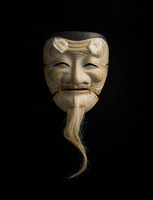「Hakushiji-jō」の版間の差分
編集の要約なし |
(相違点なし)
|
2018年4月18日 (水) 08:01時点における最新版
はくしきじょう白式尉
The white faced Hakushiki-jō mask, also known as Okina 翁, portrays a happy old man and is used in noh and festival performances of Shikisanban 式三番.
Noh Kyogen
[[Category:noh|hakushikijō]
Mask characteristics
Deep wrinkles form round patterns on his forehead and cheeks. The wavy slit eyes brim with mirth, and the joyful mouth exposes only a few stubs of teeth. The separate chin (kiriago) 切り顎 is attached by means of hemp cords passed through holes in the upper and lower jaw and waggles as the actor chants his lines. Among noh masks, this feature is unique to the Shikisanban masks. The Hakushiki-jō mask has a sparse, long white beard and pompoms made of hemp that are glued on for eyebrows. A black horizontal strip at the upper edge of the mask indicates the line where the mask meets a black lacquer hat worn in performance. Hakushiki-jō masks come in various sizes, ranging from quite large to considerably smaller than the human face.
Mask background
The Hakushiki-jō Okina mask has been considered divine. Along with the other Shikisanban masks, such as the black Kokushiki-jō worn by the Sanbasō 三番叟 player, Hakushiki-jō was set up on an altar and worshiped with ritual reverence before the performance began. Carrying it out on stage in a box and donning it in front of the audience also underscores its divinity, clearly distinguishing the actor (a man) from the masked figure filled with its spirit. Along the same lines, the Okina masks differ from other noh masks in the stylization of their features, so while other noh masks will subtly change expression with movement and shifting shadows to reflect complex emotions, Okina masks always exude a warm beneficence.
Although legend attributes the oldest Okina masks to the seventh century Prince Shōtoku, the oldest Hakushiki-jo mask identified by an original dated inscription is a 1278 mask in the Ethnologisches Museum, Staatliche Museen zu Berlin. The next oldest with a dated inscription to 1477 is one in Itsukushima Shrine, Hiroshima, but numerous others from the fourteenth and fifteenth century have been preserved in Shrines, particularly in and around the Kansai area. Each of the noh schools also treasure old Okina masks. (MB)
